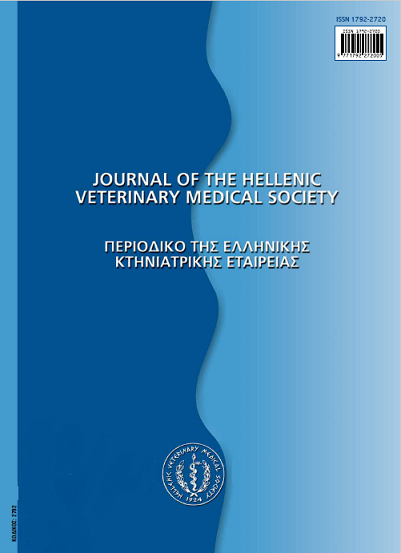‘Ξένο’ DNA από τη χορηγούμενη τροφή στον οργανισμό των ζώων και αξιολόγηση της ασφάλειας των γενετικώς τροποποιημένων ζωοτροφών
Abstract
Κατ’ αρχήν γίνεται αναφορά στη σημασία των εφαρμογών της βιοτεχνολογίας στη διατροφή των ζώων, με ιδιαίτερη αναφορά σε θέματα διαγονιδιακών φυτών, στα οποία ανήκουν οι περισσότεροι από τους γενετικώς τροποποιημένους οργανισμούς που χρησιμοποιούνται ως ζωοτροφές. Επί πλέον, υπογραμμίζεται η σημασία αυτών των φυτών ως ζωοτροφών, καθώς και η ανάγκη κάλυψης του θέματος από την Ευρωπαϊκή νομοθεσία, δεδομένου ότι ο πιο διαδεδομένος δημητριακός καρπός και ελαιούχος σπόρος παγκοσμίως (καλαμπόκι και σόγια, αντίστοιχα), καθώς και ο βαμβακόσπορος και η ελαιοκράμβη, εμπίπτουν στην παραπάνω κατηγορία πρώτων υλών. Επίσης, γίνεται αναφορά, στη διαδικασία έγκρισης των γενετικώς τροποποιημένους πρώτων υλών ζωοτροφών από την Ευρωπαϊκή Ένωση. Περαιτέρω, παρατίθενται απόψεις αναφορικά με την αποδόμηση θραυσμάτων του ‘ξένου’ DNA στην τροφή, τα οποία προέρχονται από διαγονιδιακά φυτά, στον οργανισμό του ζώου.
Σε αυτό το πνεύμα, συζητείται η μεταφορά και η τύχη του DNA από γενετικώς τροποποιημένα φυτά στο σώμα των αγροτικών ζώων και τα παραγόμενα από αυτά προϊόντα. Στη συνέχεια, προκειμένου να αντιμετωπιστεί το θέμα της θρεπτικής αξιολόγησης της ποιότητας των ζωοτροφών από γενετικώς τροποποιημένα φυτά στη χορηγούμενη στα ζώα τροφή, εισάγεται ο όρος ‘ουσιώδης ισοδυναμία’, η οποία αναφέρεται στην περιεκτικότητα σε θρεπτικά συστατικά και ανεπιθύμητες ουσίες σε τροποποιημένες και συμβατικές ζωοτροφές. Επίσης, παρουσιάζεται η εξασθένηση της ισχύος της ‘ουσιώδους ισοδυναμίας’ στην καθιέρωσή της ως κριτηρίου ασφάλειας για ζωοτροφές από διαγονιδιακά φυτά. Επιχειρείται, επίσης, ανασκόπηση της αξιολόγησης της ασφάλειας των γενετικώς τροποποιημένων ζωοτροφών, ιδιαίτερα δε του ανθεκτικού σε ζιζανιοκτόνα ή έντομα καλαμποκιού, μέσω της επίσημης διαδικασίας, όπου η εκτίμηση του κινδύνου διεξάγεται από την EFSA και η διαχείριση αυτού από την Ευρωπαϊκή επιτροπή. Η αξιολόγηση του κινδύνου των γενετικώς τροποποιημένων ζωοτροφών εξετάζει ζητήματα όπως ο μοριακός χαρακτηρισμός αυτών, η σύγκριση της σύνθεσης τροποποιημένων και (αντίστοιχων) συμβατικών ζωοτροφών και η εκτίμηση της θρεπτικής αξίας των τροποποιημένων ζωοτροφών. Τέλος, γίνεται αναφορά σε θέματα περιβαλλοντικών επιπτώσεων από τη χρήση τροποποιημένων ζωοτροφών, περιλαμβανομένων των επιπτώσεων στη βιοποικιλότητα, καθώς και σε μέτρα άμβλυνσης αυτών.
Article Details
- Zitationsvorschlag
-
ZOIOPOULOS (Π.E. ΖΩΙΟΠΟΥΛΟΣ) P. E., & NATSKOULIS (Π. ΝΑΤΣΚΟΥΛΗΣ) P. (2017). ‘Ξένο’ DNA από τη χορηγούμενη τροφή στον οργανισμό των ζώων και αξιολόγηση της ασφάλειας των γενετικώς τροποποιημένων ζωοτροφών. Journal of the Hellenic Veterinary Medical Society, 64(1), 69–83. https://doi.org/10.12681/jhvms.15481
- Ausgabe
- Bd. 64 Nr. 1 (2013)
- Rubrik
- Review Articles
Authors who publish with this journal agree to the following terms:
· Authors retain copyright and grant the journal right of first publication with the work simultaneously licensed under a Creative Commons Attribution Non-Commercial License that allows others to share the work with an acknowledgement of the work's authorship and initial publication in this journal.
· Authors are able to enter into separate, additional contractual arrangements for the non-exclusive distribution of the journal's published version of the work (e.g. post it to an institutional repository or publish it in a book), with an acknowledgement of its initial publication in this journal.
· Authors are permitted and encouraged to post their work online (preferably in institutional repositories or on their website) prior to and during the submission process, as it can lead to productive exchanges, as well as earlier and greater citation of published work.



